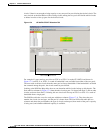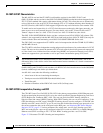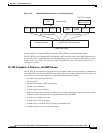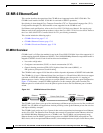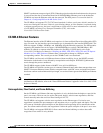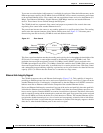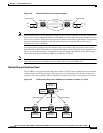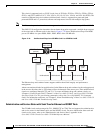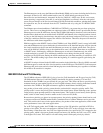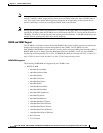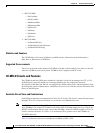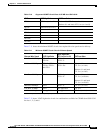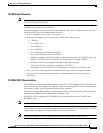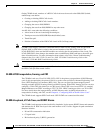
17-17
Cisco ONS 15310-CL, ONS 15310-MA, and ONS 15310-MA SDH Ethernet Card Software Feature and Configuration Guide, R9.1 and R9.2
78-19415-01
Chapter 17 CE-Series Ethernet Cards
CE-MR-6 Ethernet Card
The Ethernet ports can be set to the Enhanced State Model (ESM) service states including the In-Service,
Automatic In-Service (IS, AINS) administrative state. IS, AINS initially puts the port in the
Out-of-Service and Autonomous, Automatic In-Service (OOS-AU, AINS) state. In this service state,
alarm reporting is suppressed, but traffic is carried and loopbacks are allowed. After the soak period
passes, the port changes to In-Service and Normal (IS-NR). Raised fault conditions, whether their alarms
are reported or not, can be retrieved from the CTC Conditions tab or by using the TL1 RTRV-COND
command.
Two Ethernet port alarms/conditions, CARLOSS and TPTFAIL, can prevent the port from going into
service. This occurs even though alarms are suppressed when a CE-MR-6 circuit is provisioned with the
Ethernet ports set to the IS,AINS state, because the CE-MR-6 link integrity function is active and ensures
that the links at both ends are not enabled until all SONET and Ethernet errors along the path are cleared.
As long as the link integrity function keeps the end-to-end path down, both ports will have at least one
of the two conditions needed to suppress the AINS-to-IS transition. Therefore, the ports will remain in
the AINS state with alarms suppressed.
ESM also applies to the SONET circuits of the CE-MR-6 card. If the SONET circuit is set up in IS,AINS
state and the Ethernet error occurs before the circuit transitions to IS, then link integrity will also prevent
the circuit transition to the IS state until the Ethernet port errors are cleared at both ends. The service
state will be OOS-AU,AINS as long as the administrative state is IS,AINS. When there are no Ethernet
or SONET errors, link integrity enables the Ethernet port at each end. Simultaneously, the AINS
countdown begins as normal. If no additional conditions occur during the time period, each port
transitions to the IS-NR state. During the AINS countdown, the soak time remaining is available in CTC
and TL1. The AINS soaking logic restarts from the beginning if a condition appears again during the
soak period.
A SONET circuit provisioned in the IS,AINS state remains in the initial Out-of-Service (OOS) state until
the Ethernet ports on each end of the circuit transition to the IS-NR state. The SONET circuit transports
Ethernet traffic and counts statistics when link integrity turns on the Ethernet port, regardless of whether
this AINS-to-IS transition is complete.
IEEE 802.1Q CoS and IP ToS Queuing
The CE-MR-6 references IEEE 802.1Q class of service (CoS) thresholds and IP type of service (ToS)
(IP Differentiated Services Code Point [DSCP]) thresholds for priority queueing. CoS and ToS
thresholds for the CE-MR-6 are provisioned on a per port level. This allows the user to provide priority
treatment based on open standard quality of service (QOS) schemes already existing in the data network
attached to the CE-MR-6. The QOS treatment is applied to both Ethernet and POS ports.
Any packet or frame with a priority greater than the set threshold is treated as priority traffic. This
priority traffic is sent to the priority queue instead of the normal queue. When buffering occurs, packets
on the priority queue preempt packets on the normal queue. This results in lower latency for the priority
traffic, which is often latency-sensitive traffic such as voice-over-IP (VoIP).
Because these priorities are placed on separate queues, the priority queuing feature should not be used
to separate rate-based CIR/EIR marked traffic (sometimes done at a Metro Ethernet service provider
end). This could result in out-of-order packet delivery for packets of the same application, which would
cause performance issues with some applications.
For an IP ToS-tagged packet, the CE-MR-6 can map any of the 256 priorities specified in IP ToS to
priority or best effort. The user can configure a different ToS in CTC at the card-level view under the
Provisioning > Ether Ports tabs. Any ToS class higher than the class specified in CTC is mapped to the
priority queue, which is the queue geared towards low latency. By default, the ToS is set to 255, which
is the highest ToS value. This results in all traffic being treated with equal priority by default.



